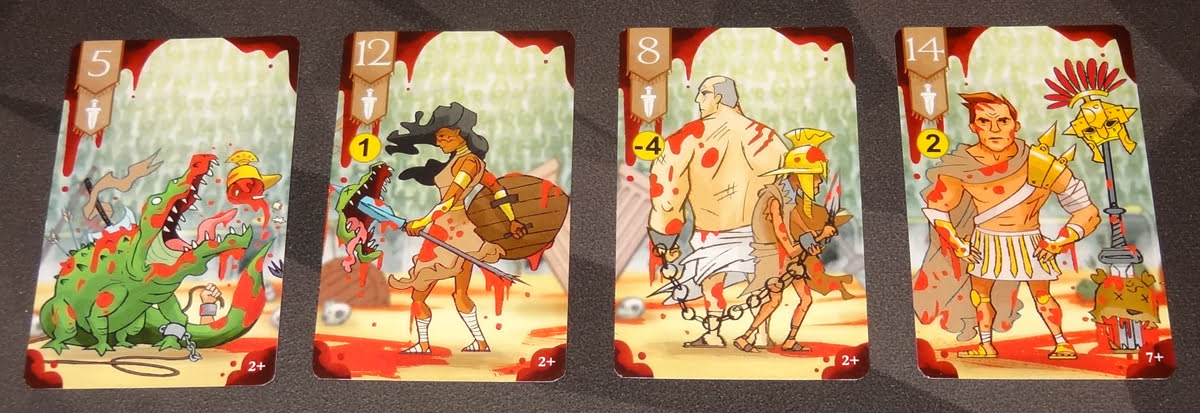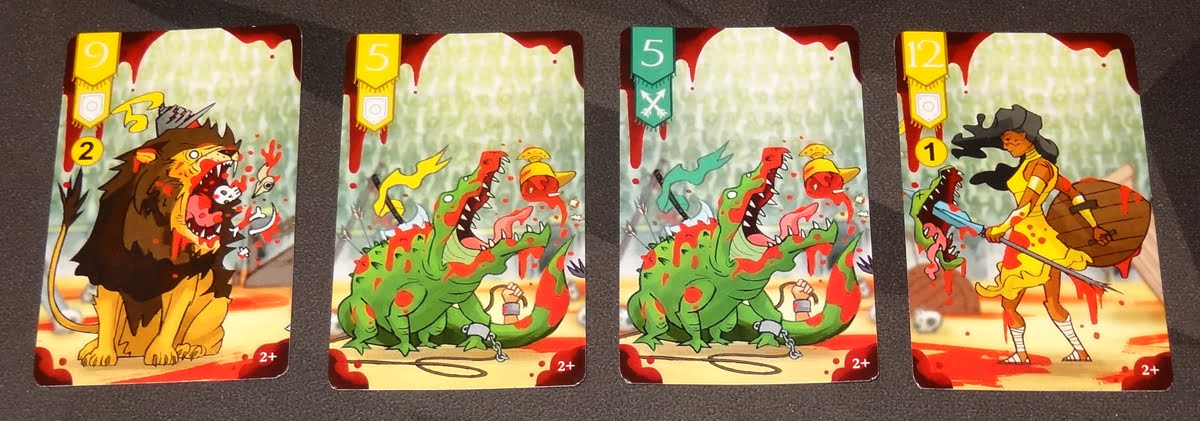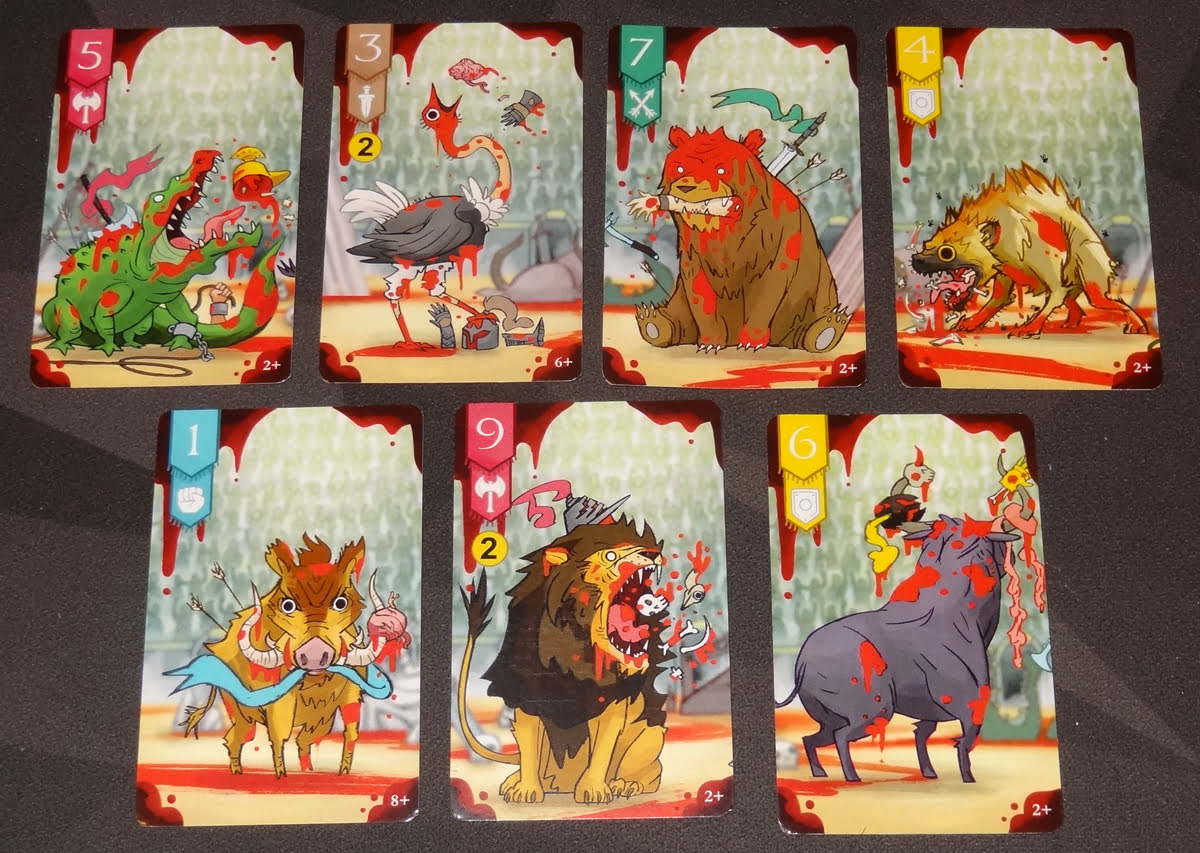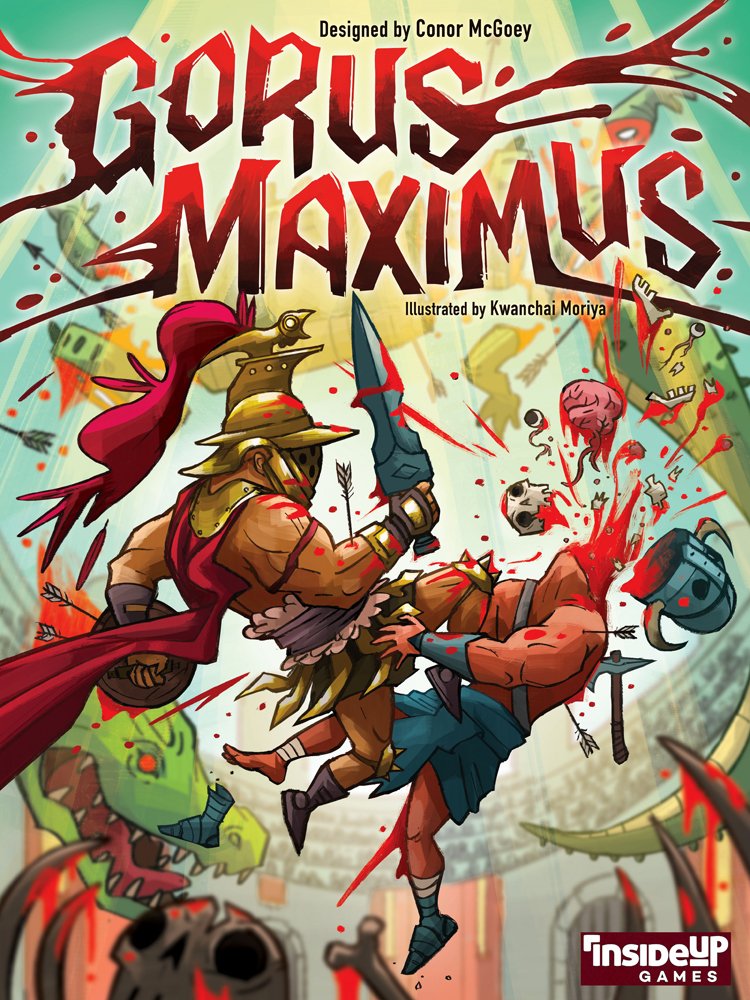 The crowds demand blood, so you have established Gorus Maximus to give them what they want. When gladiators and beasts battle to the death, you will be the real winner.
The crowds demand blood, so you have established Gorus Maximus to give them what they want. When gladiators and beasts battle to the death, you will be the real winner.
What Is Gorus Maximus?
Gorus Maximus is a trick-taking game by Conor McGoey for 2 to 8 players, ages 13 and up, and takes 20–45 minutes to play. It’s currently seeking funding on Kickstarter, with a pledge level of $19CAD (about $15USD) for a copy of the game, with a $25CAD tier available for a deluxe edition. The age rating for the game is mostly due to gory artwork rather than the gameplay itself, so you can judge for yourself whether it’s appropriate for your kids.
Note: Probably the goriest artwork is actually the front cover of the box, which I’ve placed at the very bottom of this post. It’s cartoony gore, but you can see a little bit of it above, with eyeballs and jawbones and plenty of blood spatters.
New to Kickstarter? Check out our crowdfunding primer, and visit our Kickstarter curated page for more projects we love.

Gorus Maximus Components
Note: My review is based on a prototype copy, so it is subject to change and may not reflect final component quality. In particular, the tokens in the prototype were larger than they will be in the final version, and the colors on the preferred school card are incorrect.
- Here’s what’s included:
- 80 Gladiator cards (16 gladiators in each of 5 schools)
- Preferred School card
- Preferred School marker
- Crowd Support tokens
The artwork is by Kwanchai Moriya, who has illustrated a wide variety of games. The style he uses here is closer to Catacombs than Dinosaur Island, a sort of cute, cartoony look … but then covered in blood. There’s a wide variety of gladiators and beasts, severed limbs, skulls, and so on, and it’s quite over the top.

Each card has a rank and a suit. Some cards also have numbers in a yellow circle, which represent crowd favor points. At the lower right is a small number for sorting out cards according to player count.
How to Play Gorus Maximus
You can download a copy of the rulebook here.
The Goal
The goal of the game is to be the first to score 3 Crowd Support. (In team variants, the goal score may vary.)
Setup
Set up the gladiator deck based on the number of players—the number of suits, as well as which gladiators are included, will vary based on the number of players, but you’ll end up with a deck that has 10 cards per player. Shuffle the deck, and deal out all of the cards.
Place the preferred school card and tracker in the center of the table, as well as the crowd support tokens. Choose a starting player.
Gameplay
Gorus Maximus is a trick-taking game, like Spades or Hearts, though there are some differences in scoring and, most significantly, in how the “preferred school” (trump suit) is determined. In the first trick of the game, the first card played will determine the first preferred school, but after that it will be determined by challenges.

Each “bout” (trick) consists of every player playing a single card face-up, in turn order. The first player in the trick determines the “initiating school” by playing a card. Everyone else must play a card from the same school if they have one, with one exception: if you have a gladiator of a different school that matches the rank of the last gladiator played, you may play it as a challenge. This changes the preferred school to the card you just played, but it does not change the initiating school, so other players will still need to follow suit and play the initiating school if possible. If you do not have any gladiators from the initiating school, you may play any card from your hand.

After every player has played one card, the bout is over. The highest ranked gladiator of the preferred school is the winner; if there are no gladiators of the preferred school, then the highest ranked gladiator of the initiating school is the winner. The winning player takes all of the cards from the bout and places them face-down in a scoring pile, and then starts a new trick (which sets a new initiating school for that bout).
The round ends after 10 bouts, when everyone is out of cards. Everyone reveals their scoring pile, and tallies up the crowd favor points (shown below the rank). The “0” card of the preferred school is worth 5 crowd favor points; all other “0” cards are worth nothing. The player with the highest crowd favor receives 1 crowd support token.
Then, all cards are shuffled together and dealt out and a new round begins. The preferred school resets at the beginning of the next round, based on the first card played.
Game End
The game ends when a player has earned 3 crowd support tokens—that player wins the game.
2-Player Variant
In a 2-player game, you build the deck for a 3-player game, but only deal 10 cards per player, with the rest of the cards face-down in a draw pile. Each time you play a card, you draw a replacement until they run out. Then, play until you have no more cards.
Team Variant
With at least 4 players, you can split into teams, and you can have uneven teams. One teammate per team will gather all of the scoring cards for that team. The goal is to earn crowd support equal to your team size plus one, so that if you are on a smaller team, you will need less crowd favor to win.

Why You Should Play Gorus Maximus
If you like trick-taking games but you’ve always thought “You know, this is okay, but it would be even better with more gore and viscera…” then Gorus Maximus is right up your alley. I’ll be honest: I’ve never really thought that myself. When I was a kid, I played a lot of Spades and Hearts, and in recent years I’ve seen some new trick-taking games appear on the scene, but I’ve never found a theme that really seems to tie into the trick-taking gameplay.
The theme of Gorus Maximus does actually make some sense, in that the highest ranked gladiator is the winner of the bout, and that there’s a preferred school that takes precedence over the others. I also like the way that the preferred school changes, due to a “challenge” from another school. But the metaphor only goes so far: why do different players have gladiators from multiple schools? Why are gladiators from the same school battling each other? Probably best not to read too much into it.
Basically, it’s a trick-taking game, with some new twists. Setting aside the theme, there are definitely some interesting things going on. For one, I don’t think I’ve played a trick-taking game where the trump suit changes by matching numbers. In Gorus Maximus, you might have the trump change several times in a single trick, if several players have matching numbers.
It also has a different system of scoring: instead of having your score based on the number of tricks or a bid, it’s based on the crowd favor points on certain cards. Those crowd favor numbers really change the dynamics of a typical trick-taking game, because it really matters which tricks you take, not just how many tricks you take. The dreaded 8 ranked cards have -4 crowd favor points, and everyone groans when those are played. Can you pass off your 8 to another player, or will everyone have lower cards to slough off? The 0 ranked cards, which are only worth points if the right school is preferred at the end of the round, can be tricky to claim: unless it’s the only card in the initiating school, or the only trump card played, chances are if you play the 0, you’re giving it to somebody else.

All of these make Gorus Maximus a tricky game to figure out: when to challenge the preferred school, what to lead with if it’s your turn, how to distribute your cards with crowd favor points. And since the winner of the round just gets a single crowd support point, it doesn’t matter if you’re in second place or last or how close you were to first—you’re just 1 point behind in the scoring that matters. That means even if you have a terrible round, all is not lost, and it’s still possible to catch up on the next round.
I think I prefer the team game, simply because it opens up more tactics. You can throw in a potentially valuable 0 card when your teammate is winning the trick, or change up the trump suit when your teammate leads with a weak card. The rules don’t really state what sort of communication is allowed, so that’s something you’ll just have to decide with your gaming group, but I liked the group dynamic more when people had shared stakes in a bout.
Ultimately, I’ve enjoyed playing Gorus Maximus but I’m not a huge fan of the theme myself. My daughters just weren’t really interested in trying the game because they were turned off by the theme, and I’ve had some in my gaming group hesitate when they saw the cover. On the other hand, there may be people who have never really played trick-taking games who might discover Gorus Maximus because of the theme and artwork, and then discover the breadth of this classic genre. If you like trick-taking games and you like what you see here, Gorus Maximus might be a crowd-pleaser at your game night.
For more information or to make a pledge, visit the Gorus Maximus Kickstarter page!
And now, the full cover in all its visceral detail:
Click here to see all our tabletop game reviews.
![]() To subscribe to GeekDad’s tabletop gaming coverage, please copy this link and add it to your RSS reader.
To subscribe to GeekDad’s tabletop gaming coverage, please copy this link and add it to your RSS reader.
Disclosure: GeekDad received a copy of this game for review purposes.






‘For one, I don’t think I’ve played a trick-taking game where the trump suit changes by matching numbers.’ Yes, this is a brilliant touch – suspense and surprises are guaranteed throughout the entire game. I also like the 0 card rule and the negative CF points. And this is the only trick-taking game I know that accommodates up to 8 players.
Yes, the 8-player trick-taking game is definitely a rare beast, and I can’t think of any off the top of my head either. With 8 players I definitely recommend team play, though, because otherwise it could be a very long game.